Dodge T-, V-, W-Series on:
[Wikipedia]
[Google]
[Amazon]
In 1939
/ref> Historic author on Dodge trucks, Don Bunn, noted that the 1939 to 1947 Job-Rated trucks represent a very significant segment in Dodge history. They were the first to be mass-produced in the new, huge (Mound Road) Warren truck plant. The Job-Rated trucks also formed the basis for Dodge's first light-duty military four-wheel drives, the 1940 half-ton Dodge VC series, which in turn further developed into the world's first factory 4WD commercial pickups: the Dodge Power Wagon. And lastly, Dodge was the first of the Big Three U.S. auto manufacturers to offer a diesel powered truck — all the more exceptional, given that Chrysler engineered and built their heavy-duty diesel engines all in-house. Today, this series is the most popular pickups with Dodge truck collectors.
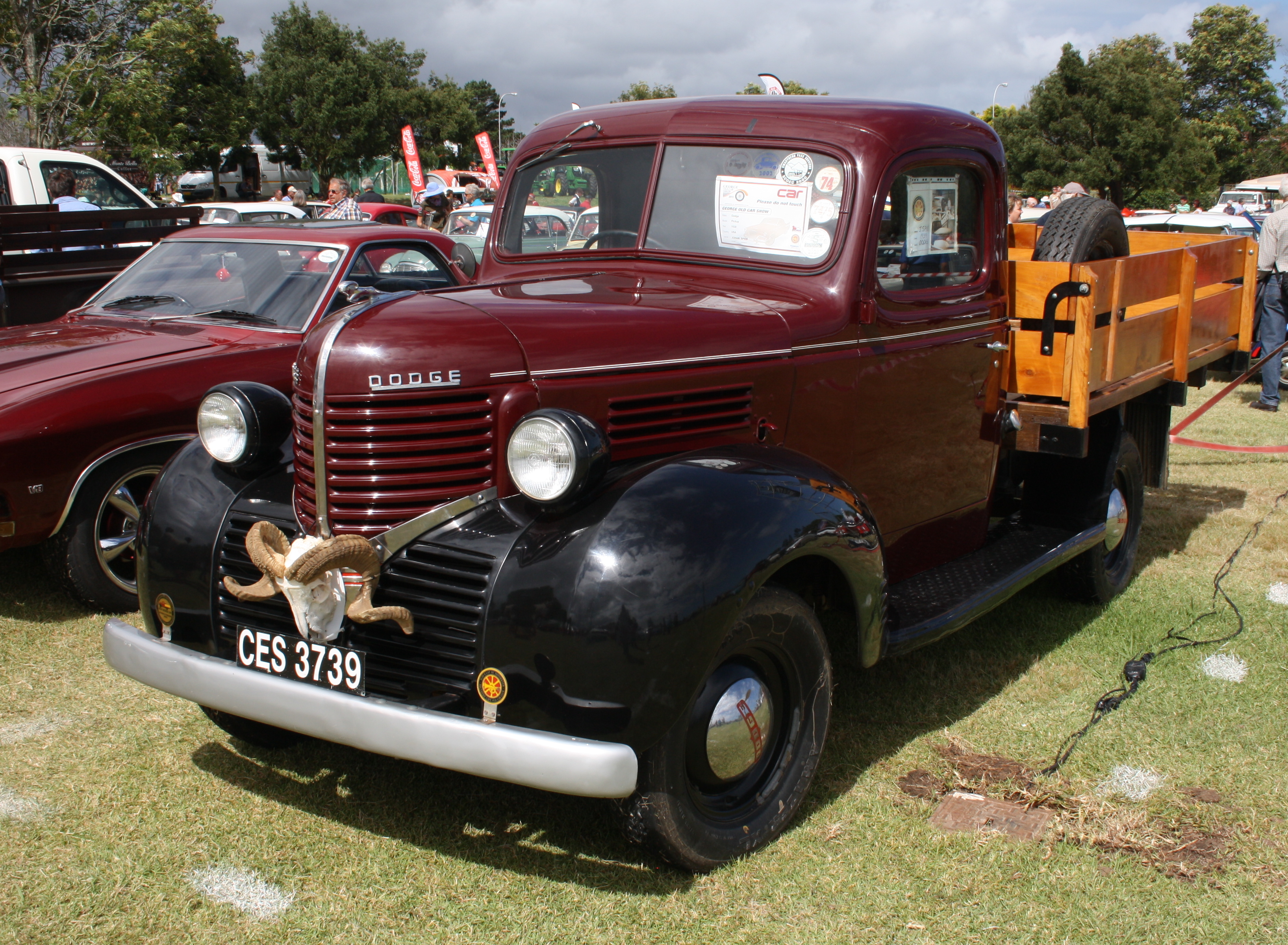
 After Dodge joined forces with Graham Brothers trucks from 1925 onwards, Dodge and Graham trucks, marketed through Dodge's vast dealer network, were offered in various capacities, ranging from a half ton to three tons. In May 1928 ''Power Wagon'' magazine already computed a "truly impressive" 1,842 possible configuration combinations, of available models, styles, payload ratings and other options."The Graham Legacy: Graham-Paige To 1932"
After Dodge joined forces with Graham Brothers trucks from 1925 onwards, Dodge and Graham trucks, marketed through Dodge's vast dealer network, were offered in various capacities, ranging from a half ton to three tons. In May 1928 ''Power Wagon'' magazine already computed a "truly impressive" 1,842 possible configuration combinations, of available models, styles, payload ratings and other options."The Graham Legacy: Graham-Paige To 1932"
by M Keller. – Antique Automobile Club of America (archived 05-06-2019) For 1939, Dodge rolled out a striking, modern design, new from the ground up, except for the updated
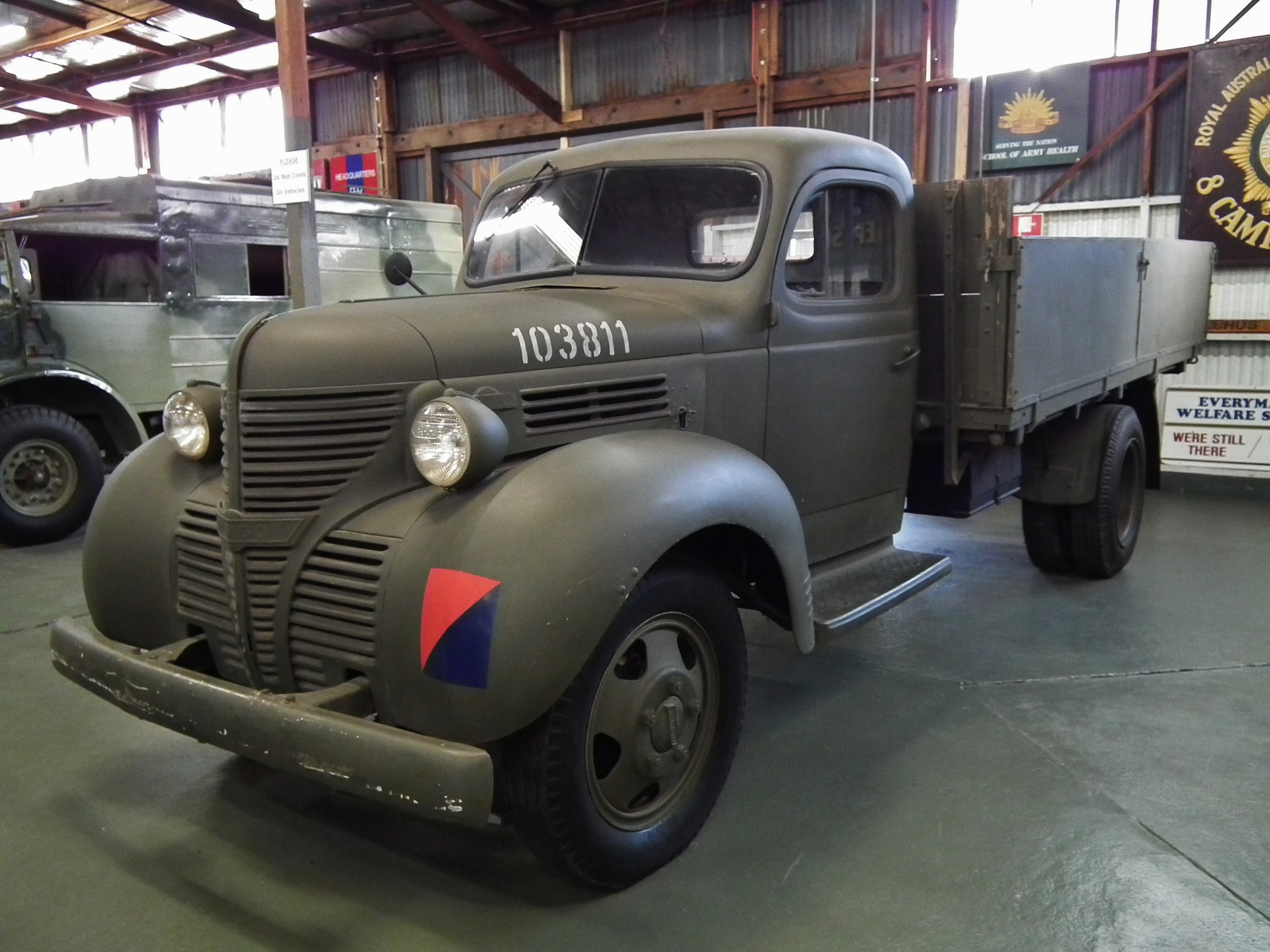 After Dodge supplied the U.S. Army with its first four-wheel drive truck in 1934, more modern -tonners were developed, and 1,700 RF-40-X-4(USA) trucks were supplied in 1938, and 292 TF-40-X-4(USA) in 1939.1943 Dodge WC-51 Weapons Carrier, Power & Glory – FourWheeler.com
After Dodge supplied the U.S. Army with its first four-wheel drive truck in 1934, more modern -tonners were developed, and 1,700 RF-40-X-4(USA) trucks were supplied in 1938, and 292 TF-40-X-4(USA) in 1939.1943 Dodge WC-51 Weapons Carrier, Power & Glory – FourWheeler.com
/ref> In 1940, Dodge gained an Army contract to design and build -ton 4×4 military trucks in several styles using many commercial truck parts. Based on the VC-Series, and internally called the T-202 series, the VC-1 through VC-6 came with essentially stock front-end sheetmetal. Similarly, their 116-inch wheelbase and 201-cubic-inch 79-horsepower six-cylinder engine shared much with Dodge's civilian -ton VC. The following year, the T202 was replaced by the T-207 series trucks. Again rated as -tonners, they featured a military-specific hood, grille, and fenders. These trucks were powered by the 218-cubic-inch six of 85 horsepower taken from Dodge's - and one-ton commercial models.
/ref> Eventually, the military trucks were substantially redesigned, and uprated to -tons with a 230-cubic-inch engine with 92 hp. Together with the 1941 -tons, these were built from 1942 until the end of the war as the Dodge WC series military trucks. Some 30 were modified as armored trucks by the French in
 The U.S. military also used some of Dodge's light truck models in mostly stock, two-wheel drive form. Technical manuals of U.S. Army military vehicles offer some more detailed specifications on three such models: the 1947 model year WC and WD-15 models, and the 160 inch wheelbase version of the SNL G-number 618 aka the WF-32.
Additionally there were 4x2, civilian based variants built either as Canadian "Modified Conventional Pattern" or " Canadian Military Pattern trucks", called the D15 (15cwt, or ¾-ton – engineering code T-222), and the D60S and D60L (60cwt, or 3-ton, engineering code T-110, with a short or long wheelbase). The Canadian models were built with a engine with a 25" block, that was unique to them, and they had beefed up rear axles. Chrysler Corporation of Canada produced a total of 180,816 military Dodge trucks during 1939-1945.
The U.S. military also used some of Dodge's light truck models in mostly stock, two-wheel drive form. Technical manuals of U.S. Army military vehicles offer some more detailed specifications on three such models: the 1947 model year WC and WD-15 models, and the 160 inch wheelbase version of the SNL G-number 618 aka the WF-32.
Additionally there were 4x2, civilian based variants built either as Canadian "Modified Conventional Pattern" or " Canadian Military Pattern trucks", called the D15 (15cwt, or ¾-ton – engineering code T-222), and the D60S and D60L (60cwt, or 3-ton, engineering code T-110, with a short or long wheelbase). The Canadian models were built with a engine with a 25" block, that was unique to them, and they had beefed up rear axles. Chrysler Corporation of Canada produced a total of 180,816 military Dodge trucks during 1939-1945.
The trucks were built with a near standard civilian closed cab – right-hand drive because Burma was under British rule – but fitted with a flat, military-style grille & brush guard, and wide open, almost flat fenders, to avoid mud build-up clogging the wheels rotating, and otherwise stood out by having a 60-gallon fuel tank. In order for the trucks to function on the gruelling journey over the Himalayas, Dodge fitted not only heavy-duty springs and steering gear, but went sofar as to fit tri-metal aircraft grade bearings and aeroplane-type shock absorbers. Radiators were fitted with an overflow tank, to return the cooled water to the sealed cooling system. Ground clearance was , with a 50° approach angle, and 28.5° departure. Front axles were widened to give wider tread. Nevertheless, the average life of the trucks was only about five trips. It has been commented that the front sheet metal design of the T-234 Burma Dodge shows remarkable resemblance to that of the post-war Dodge Power Wagons, and may well have influenced it.
File:BURMA DODGE FRAME— IMAGE FROM T-234 MANUAL.jpg, Burma Dodge frame – wheelbase
File:Dodge T-234 331 CI engine.jpg, T-234, 331 CI engine, originally a diesel
File:Dodge T-234 chinese truck dashboard Mil. Manual photo.jpg, T-234 interior dashboard
File:Dodge T-234 – 1940-prototype US Archive.jpg, T-234 – prototype
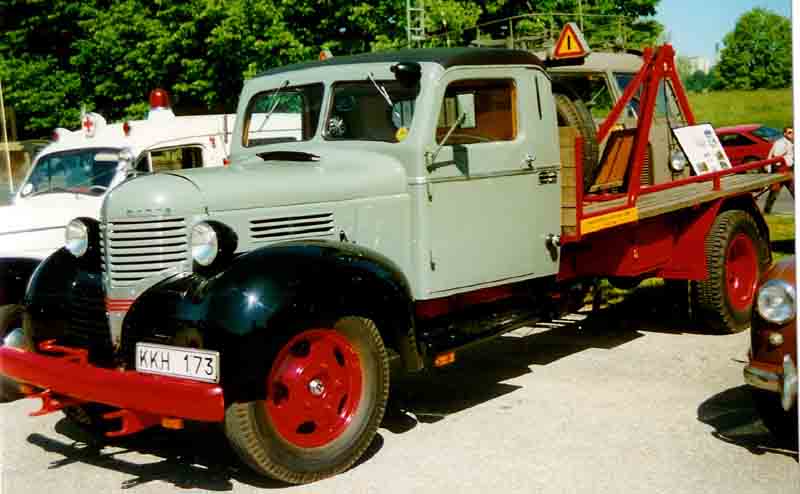
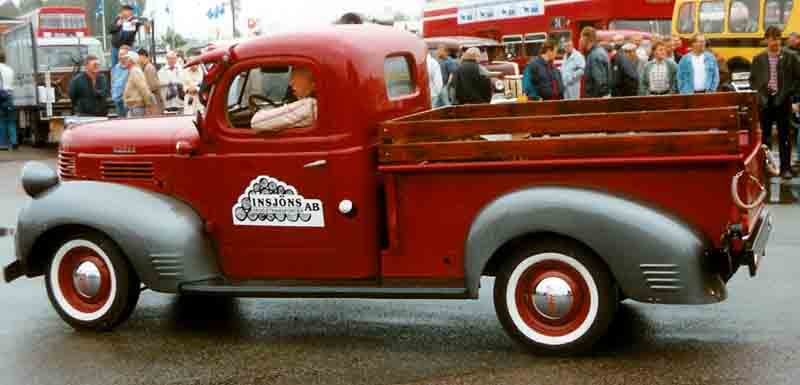

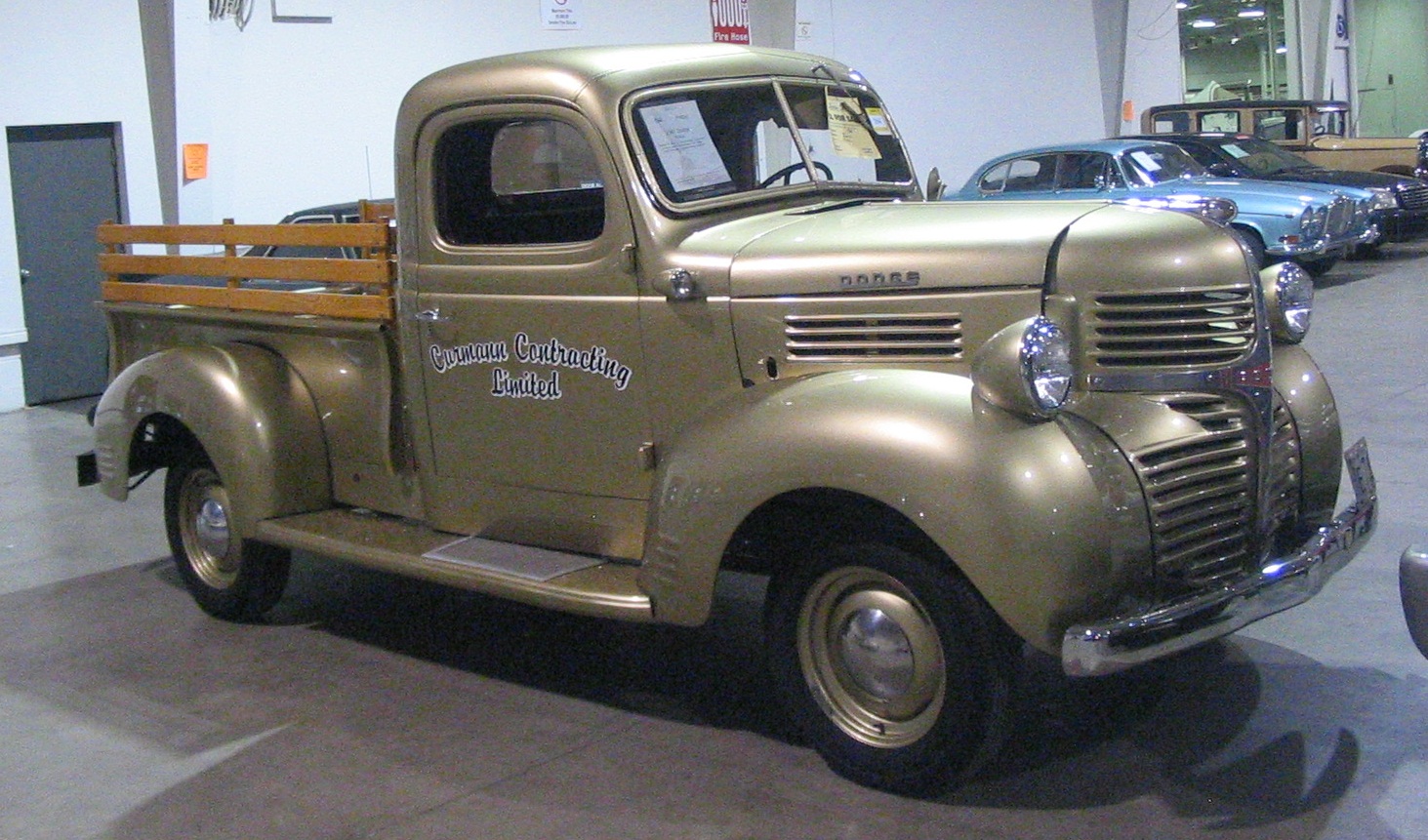
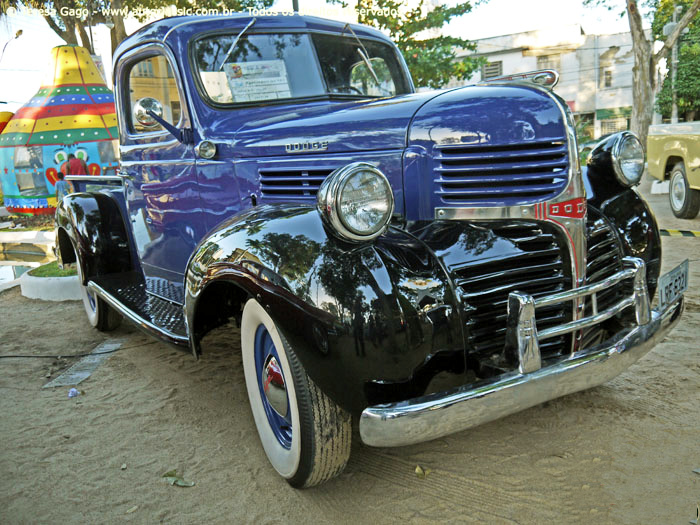 Dodge offered their 1939–1947 'Job-Rated' trucks in many variants. complemented with information about Dodge engine & engineering codes from the same website,T Flathead Six Engines
Dodge offered their 1939–1947 'Job-Rated' trucks in many variants. complemented with information about Dodge engine & engineering codes from the same website,T Flathead Six Engines
T137.com.
– townwagon.com Models with a "D" as the ''third'' letter in the model code, and marked with "D" behind the engine code, indicate models that were offered with a diesel engine.
Dodge
Dodge is an American brand of automobiles and a division of Stellantis, based in Auburn Hills, Michigan. Dodge vehicles have historically included performance cars, and for much of its existence Dodge was Chrysler's mid-priced brand above P ...
presented a completely new designed line of pickups and trucks. Formally the T series for 1939, V series for 1940, and the W series from 1941 through 1947, the trucks became mostly known as the Dodge Job-Rated trucks.
With streamlined, Art Deco style
Art Deco, short for the French ''Arts Décoratifs'', and sometimes just called Deco, is a style of visual arts, architecture, and product design, that first appeared in France in the 1910s (just before World War I), and flourished in the Unit ...
d front sheetmetal, and introducing the concept of "Job-Rated" truck configurations, Dodge tried to offer customers the truck that fit the job they were buying it for.
As a result, the 1939 to 1947 Dodge pickup / truck range was offered in a bewilderingly large number of available variants and model codes.
Six different payload classes, a wide range of bodies, and more than twenty different wheelbase-lengths were manufactured, and fitted with different sized versions of the Chrysler-sourced inline six-cylinder side-valve engines — from the half-ton TC pickup on a 116-inch wheelbase to three-ton tractor cabs. Nevertheless, mechanically, the trucks were all very similar, with solid axles front and rear and leaf springs at all four corners. With World War II taking up most of production capacity from 1942 to 1945, the 1939 styling continued largely unchanged through 1947, as engineering and production became the main focus.
The Dodge trucks enjoyed some popularity before the war, and the last of them built in 1942, before Dodge turned to mostly military production, had progressed to the
W-series model name. When they resumed sales post-war, they continued as the 1946 Dodge W-series.1946 Dodge WC Pickup – howstuffworks/ref> Historic author on Dodge trucks, Don Bunn, noted that the 1939 to 1947 Job-Rated trucks represent a very significant segment in Dodge history. They were the first to be mass-produced in the new, huge (Mound Road) Warren truck plant. The Job-Rated trucks also formed the basis for Dodge's first light-duty military four-wheel drives, the 1940 half-ton Dodge VC series, which in turn further developed into the world's first factory 4WD commercial pickups: the Dodge Power Wagon. And lastly, Dodge was the first of the Big Three U.S. auto manufacturers to offer a diesel powered truck — all the more exceptional, given that Chrysler engineered and built their heavy-duty diesel engines all in-house. Today, this series is the most popular pickups with Dodge truck collectors.
General

 After Dodge joined forces with Graham Brothers trucks from 1925 onwards, Dodge and Graham trucks, marketed through Dodge's vast dealer network, were offered in various capacities, ranging from a half ton to three tons. In May 1928 ''Power Wagon'' magazine already computed a "truly impressive" 1,842 possible configuration combinations, of available models, styles, payload ratings and other options."The Graham Legacy: Graham-Paige To 1932"
After Dodge joined forces with Graham Brothers trucks from 1925 onwards, Dodge and Graham trucks, marketed through Dodge's vast dealer network, were offered in various capacities, ranging from a half ton to three tons. In May 1928 ''Power Wagon'' magazine already computed a "truly impressive" 1,842 possible configuration combinations, of available models, styles, payload ratings and other options."The Graham Legacy: Graham-Paige To 1932"by M Keller. – Antique Automobile Club of America (archived 05-06-2019) For 1939, Dodge rolled out a striking, modern design, new from the ground up, except for the updated
drivetrain
A drivetrain (also frequently spelled as drive train or sometimes drive-train) is the group of components that deliver mechanical power from the prime mover to the driven components. In automotive engineering, the drivetrain is the components o ...
s – and, as before, offering an exceptionally large number of available variants. In the later 1930s, streamlined styling had become a virtual requirement for anything from appliances, cars, boats, planes — even trucks, trains, and architecture. The new, 'Job-Rated' Dodge trucks followed suit, and were completely representative of the 'Streamline Moderne
Streamline Moderne is an international style of Art Deco architecture and design that emerged in the 1930s. Inspired by aerodynamic design, it emphasized curving forms, long horizontal lines, and sometimes nautical elements. In industrial desig ...
', Art Deco
Art Deco, short for the French ''Arts Décoratifs'', and sometimes just called Deco, is a style of visual arts, architecture, and product design, that first appeared in France in the 1910s (just before World War I), and flourished in the Unit ...
based style, inspired by aerodynamic
Aerodynamics, from grc, ἀήρ ''aero'' (air) + grc, δυναμική (dynamics), is the study of the motion of air, particularly when affected by a solid object, such as an airplane wing. It involves topics covered in the field of fluid dyn ...
design, and characterized by elongated horizontal lines and curving forms, to give the impression of sleekness and modernity.
The all new, all-steel cabs featured a front-end design with a barrel-shaped base, and a sharp V-shaped grille; long, sleek, crowned front and rear fenders, with embossed "speed lines" on the lower rears of each fender – and a new sloped, two-piece windshield, that could be opened for increased airflow. The headlamps were still free-standing, but were mounted in bullet-shaped pods. From the half-tons to the three-ton models, the new trucks all featured the same distinctive design – the heavy-duty models only stood out taller, on larger wheels and tires.
The unique styling of the trucks, was only really changed in 1940, when Dodge trucks began using sealed-beam headlamps and were equipped with marker light
The term Marker may refer to:
Common uses
* Marker (linguistics), a morpheme that indicates some grammatical function
* Marker (telecommunications), a special-purpose computer
* Boundary marker, an object that identifies a land boundary
* Marker ...
s mounted on the headlamp housing. For the most part, after 1940, year-to-year appearance changes were very minimal. The grille design was slightly changed again in 1941, and this style continued through 1947, except for the lower chrome strips, which were omitted post war.
The Job-Rated trucks had stronger frames than previous Dodge trucks, using steel with a higher tensile strength
Ultimate tensile strength (UTS), often shortened to tensile strength (TS), ultimate strength, or F_\text within equations, is the maximum stress that a material can withstand while being stretched or pulled before breaking. In brittle materials ...
, and the frame-rails extended further forward past the engine than before, such that the truck's beefy, channel-type bumpers tied the rails together, reinforcing the frame. After World War II, several changes were made to production truck chassis parts, based on reliability experience gained during military service – for instance stronger differentials and larger axle shafts were used in post-war trucks, and steering boxes were beefed up as well.
All in all, Dodge advertised as many as 175 basic chassis models, and seven engine variants, as well as different "job-rated" choices of clutches, transmissions, axles, gear ratios, springs, tires and brakes. In 1941, General Motors introduced new trucks for Chevrolet and GMC, that literally became known as their Art Deco trucks, and advertised them as "The Right Trucks for all Trades". Both Dodge's 'job-rated' trucks, and GM's 'Art-Decos' are recognized as prime truck examples of the 1930s Streamline Moderne
Streamline Moderne is an international style of Art Deco architecture and design that emerged in the 1930s. Inspired by aerodynamic design, it emphasized curving forms, long horizontal lines, and sometimes nautical elements. In industrial desig ...
architecture and design style.
Model name codes
Introduced as the T-Series for the 1939 model year, the line evolved into the V-series for 1940, and W-series for 1941, but the 'W' was retained until the end of sales in 1947. The bottom of the range TC, and its successors VC and WC, were -ton rated, on a wheelbase. As the second letter in the model code progressed in the alphabet, the payload rating typically also went up, however this was not implemented consistently. Although the TD-15, VD-15 and WD-15 were -ton rated, the TD-20 and -21 and its later VD and WD versions were one-tonners. The -15s and the -20s had a wheelbase, but the 1-ton could also be had with (the TD-/VD-/WD-21). Second letter 'E' models only existed in the form of the 1939 TE versions. TF-, VF-, and WF-models were either 1-ton or -ton,Except for the 1940 -ton rated VF-27 through VF-29 ranging in wheelbase from . Second letter G- and H-models were consistently -ton and 2-ton rated, respectively, ranging in wheelbase from . The -ton rated J-models weren't introduced until the 1946 WJ-55 through WJ-59, ranging from in wheelbase. The K-lettered models were consistently 3-ton rated, but the L-lettered models went against the naming pattern – they were only 2-ton rated. Both were offered in wheelbases ranging through 1942. From 1946 instead there were 3-ton WK- and WR-models ranging in wheelbase from .Engine
Dodge's Job-Rated trucks used flathead sixes, originally developed by Plymouth, throughout the 1939–1947 range. In the light half-ton trucks initially a 201.3 cu.in. engine was standard; with in 1939, but uprated to in 1940, and by 1941. The three-quarter and one-ton trucks used a 217.8 cu.in. engine from 1939 to 1941, rated at initially, then at 82 Hp, and at in 1941. Starting in 1942 (just before civilian production ended), the 201.3 cu.in. engines were dropped from the range, and the -ton light-duty models received the larger 218 cu.in. six, like the 3/4-ton pickups, going up to gross after the war, while the one-ton trucks got a larger 230.2 cu.in. (instead of the 218), with , until the line-up was replaced in 1947. A three-speed manual was standard issue, while a four-speed with a compound first gear was an option. The 1939–1947 TK- and TL- through WK- and WL-models were also available with adiesel engine
The diesel engine, named after Rudolf Diesel, is an internal combustion engine in which ignition of the fuel is caused by the elevated temperature of the air in the cylinder due to mechanical compression; thus, the diesel engine is a so-cal ...
– Dodge's own diesel engine – Dodge and Mack Trucks
Mack Trucks, Inc., is an American truck manufacturing company and a former manufacturer of buses and trolley buses. Founded in 1900 as the Mack Brothers Company, it manufactured its first truck in 1905 and adopted its present name in 1922. Mack ...
were the only two American automakers of the period before World War II, to have their own diesel engines. An additional 6-volt auxiliary generator debuted in 1941 on the diesel engines. The unit furnished power for lighting, instruments, and horns. Diesel sales were extremely limited however, counting as many as 75 units sold in 1939, 134 units in 1940, and 195 rigs in 1941.
Bodies and options
Besides with the "Express" pick-up bodywork, the Job-Rated trucks were available in cab/chassis,cowl
A cowl is an item of clothing consisting of a long, hooded garment with wide sleeves, often worn by monks.
Originally it may have referred simply to the hooded portion of a cloak. In contemporary usage, however, it is distinguished from a clo ...
/chassis, or bare chassis (for third party custom body) versions.
At the bottom of the range, Dodge offered the three now common pick-up classes (-ton, -ton and one-ton), as well as a 1-ton pick-up. Dodge's half-ton pickups, on a wheelbase with a 7-foot box, were changed to the 70 HP 201 cu.in. L-head straight-six. The 3/4- and 1-ton models kept the 75 HP 218 cubic inch L-head six, either on a wheelbase with a 7-foot box, or a wheelbase with a 9-foot bed. Dodge's 1-ton pick-up, offered from the Job-Rated trucks launch in 1939 until the 1942 switch to all-wartime production, consisted of the long-wheelbase one-ton model with 9-foot bed, but on bigger wheels and tires.
Aside from as pickups, the lightest models in the range, the wheelbase TC/VC/WC half-tons, were also offered as a delivery truck, either with solid steel "panel" van body, or open canvas-covered canopy or screenside configuration.
After the war, both the 1-ton pickup, and the long one-ton pickup with the nine-foot bed were dropped.
Post-war available equipment options included a larger clutch, four-speed transmission, oversize tires, electric driver's wiper, heater, chrome windshield frame, adjustable visor, driver's armrest, dome light, turn signals, "airfoam" seat with leather upholstery, and an AM radio.
Models used by the military
Purpose-built four-wheel drive
 After Dodge supplied the U.S. Army with its first four-wheel drive truck in 1934, more modern -tonners were developed, and 1,700 RF-40-X-4(USA) trucks were supplied in 1938, and 292 TF-40-X-4(USA) in 1939.1943 Dodge WC-51 Weapons Carrier, Power & Glory – FourWheeler.com
After Dodge supplied the U.S. Army with its first four-wheel drive truck in 1934, more modern -tonners were developed, and 1,700 RF-40-X-4(USA) trucks were supplied in 1938, and 292 TF-40-X-4(USA) in 1939.1943 Dodge WC-51 Weapons Carrier, Power & Glory – FourWheeler.com/ref> In 1940, Dodge gained an Army contract to design and build -ton 4×4 military trucks in several styles using many commercial truck parts. Based on the VC-Series, and internally called the T-202 series, the VC-1 through VC-6 came with essentially stock front-end sheetmetal. Similarly, their 116-inch wheelbase and 201-cubic-inch 79-horsepower six-cylinder engine shared much with Dodge's civilian -ton VC. The following year, the T202 was replaced by the T-207 series trucks. Again rated as -tonners, they featured a military-specific hood, grille, and fenders. These trucks were powered by the 218-cubic-inch six of 85 horsepower taken from Dodge's - and one-ton commercial models.
/ref> Eventually, the military trucks were substantially redesigned, and uprated to -tons with a 230-cubic-inch engine with 92 hp. Together with the 1941 -tons, these were built from 1942 until the end of the war as the Dodge WC series military trucks. Some 30 were modified as armored trucks by the French in
Syria
Syria ( ar, سُورِيَا or سُورِيَة, translit=Sūriyā), officially the Syrian Arab Republic ( ar, الجمهورية العربية السورية, al-Jumhūrīyah al-ʻArabīyah as-Sūrīyah), is a Western Asian country loc ...
prior to WWII and known as the ''Automitrailleuse Dodge Tanake''. The Tanake was fitted with a 37mm cannon M1916 and two or three FM 24/29 light machine gun
The Fusil-mitrailleur Modèle 1924 M29 (or MAC 24/29), designed in 1924 by the Manufacture d'Armes de Châtellerault, was the standard light machine gun of the French Army from 1925 until the 1960s and was in use until 2000-2006 with the National ...
s and a crew of 5. The vehicles served with French Foreign Legion, both Vichy and Free French
Free France (french: France Libre) was a political entity that claimed to be the legitimate government of France following the dissolution of the Third Republic. Led by French general , Free France was established as a government-in-exile ...
units during WWII and post-war used by the Syrian government in the 1948 Arab–Israeli War
The 1948 (or First) Arab–Israeli War was the second and final stage of the 1948 Palestine war. It formally began following the end of the British Mandate for Palestine at midnight on 14 May 1948; the Israeli Declaration of Independence had ...
.
Stock models and specifications
 The U.S. military also used some of Dodge's light truck models in mostly stock, two-wheel drive form. Technical manuals of U.S. Army military vehicles offer some more detailed specifications on three such models: the 1947 model year WC and WD-15 models, and the 160 inch wheelbase version of the SNL G-number 618 aka the WF-32.
Additionally there were 4x2, civilian based variants built either as Canadian "Modified Conventional Pattern" or " Canadian Military Pattern trucks", called the D15 (15cwt, or ¾-ton – engineering code T-222), and the D60S and D60L (60cwt, or 3-ton, engineering code T-110, with a short or long wheelbase). The Canadian models were built with a engine with a 25" block, that was unique to them, and they had beefed up rear axles. Chrysler Corporation of Canada produced a total of 180,816 military Dodge trucks during 1939-1945.
The U.S. military also used some of Dodge's light truck models in mostly stock, two-wheel drive form. Technical manuals of U.S. Army military vehicles offer some more detailed specifications on three such models: the 1947 model year WC and WD-15 models, and the 160 inch wheelbase version of the SNL G-number 618 aka the WF-32.
Additionally there were 4x2, civilian based variants built either as Canadian "Modified Conventional Pattern" or " Canadian Military Pattern trucks", called the D15 (15cwt, or ¾-ton – engineering code T-222), and the D60S and D60L (60cwt, or 3-ton, engineering code T-110, with a short or long wheelbase). The Canadian models were built with a engine with a 25" block, that was unique to them, and they had beefed up rear axles. Chrysler Corporation of Canada produced a total of 180,816 military Dodge trucks during 1939-1945.
Dodge T-234 "China / Burma" truck
A special case in between stock commercial and dedicated military trucks, was the T-234 "China / Burma Road" truck, which was built as part of the Allied cooperation with China against Japan, in the war and just thereafter. From October 1944 through March 1946, Dodge built 15,000 trucks, that used a special order combination of their most heavy-duty off-the-shelf components, to overland supplies from India to China over the very rough Ledo Road (later renamed afterJoseph Stilwell
Joseph Warren "Vinegar Joe" Stilwell (March 19, 1883 – October 12, 1946) was a United States Army general who served in the China Burma India Theater during World War II. An early American popular hero of the war for leading a column walking ...
), to an extent to specifications personally drawn up by Generalissimo Chiang Kai-shek
Chiang Kai-shek (31 October 1887 – 5 April 1975), also known as Chiang Chung-cheng and Jiang Jieshi, was a Chinese Nationalist politician, revolutionary, and military leader who served as the leader of the Republic of China (ROC) from 1928 ...
, then president and commander of the Nationalist Chinese forces. Chiang Kai-shek asked Roosevelt himself for 15,000 two-and-a-half-ton trucks capable of handling the Burma Road, requiring them to have an engine of at least 300 cubic inches and a 5-speed transmission.The trucks were built with a near standard civilian closed cab – right-hand drive because Burma was under British rule – but fitted with a flat, military-style grille & brush guard, and wide open, almost flat fenders, to avoid mud build-up clogging the wheels rotating, and otherwise stood out by having a 60-gallon fuel tank. In order for the trucks to function on the gruelling journey over the Himalayas, Dodge fitted not only heavy-duty springs and steering gear, but went sofar as to fit tri-metal aircraft grade bearings and aeroplane-type shock absorbers. Radiators were fitted with an overflow tank, to return the cooled water to the sealed cooling system. Ground clearance was , with a 50° approach angle, and 28.5° departure. Front axles were widened to give wider tread. Nevertheless, the average life of the trucks was only about five trips. It has been commented that the front sheet metal design of the T-234 Burma Dodge shows remarkable resemblance to that of the post-war Dodge Power Wagons, and may well have influenced it.
Specifications table
This table offers specifications for a few high-profile models in the extensive 1939–1947 range only.Model table



 Dodge offered their 1939–1947 'Job-Rated' trucks in many variants. complemented with information about Dodge engine & engineering codes from the same website,T Flathead Six Engines
Dodge offered their 1939–1947 'Job-Rated' trucks in many variants. complemented with information about Dodge engine & engineering codes from the same website,T Flathead Six EnginesT137.com.
– townwagon.com Models with a "D" as the ''third'' letter in the model code, and marked with "D" behind the engine code, indicate models that were offered with a diesel engine.
See also
* Chevrolet AK / BK / etc. series – a contemporaneous American truck series, popularly called the Chevy 'Art Deco' trucks.Notes
References
External links
{{WWII US Soft Vehicles T- V- W-Series (1939-1947) Pickup trucks Rear-wheel-drive vehicles 1940s cars Military vehicles introduced in the 1930s